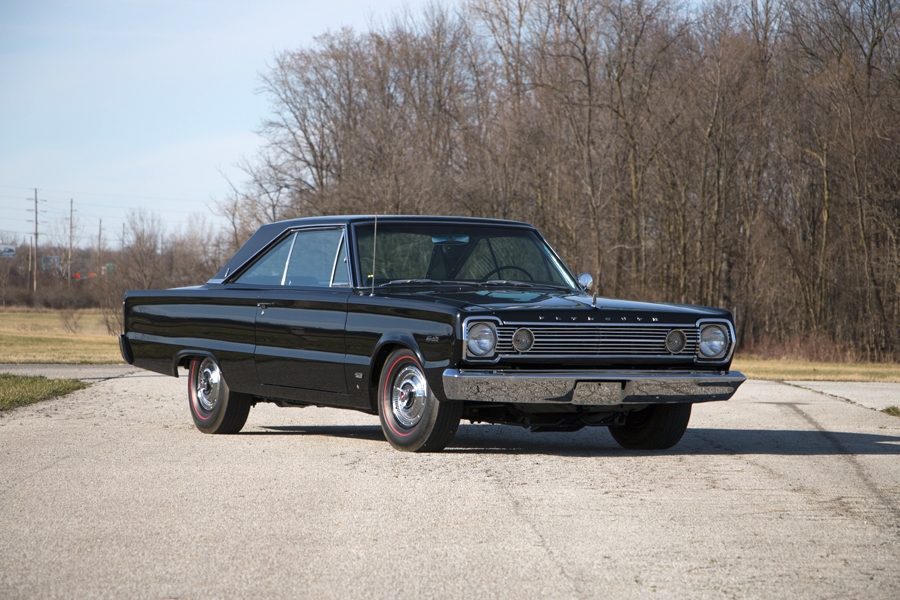- 426-ci 425-hp Hemi V8 engine
- Hurst console shift 4-speed manual transmission
- Frame-off rotisserie restoration in 2013
- Owner states this car is one of 503 with this engine/transmission combination
- Two 4-barrel carburetors
- Dana 60 rear end with 3:55 gears
- Radio
- Bucket seats
- Spinner hubcaps on steel wheels
- Redline tires
SCM Analysis
Detailing
| Vehicle: | 1966 Plymouth Satellite Hemi |
| Years Produced: | 1966–67 |
| Number Produced: | 817 |
| Original List Price: | $4,360 |
| SCM Valuation: | Median to date, $77,000; high sale, $124,200 |
| Tune Up Cost: | $300 |
| Distributor Caps: | $11.95 |
| Chassis Number Location: | Plate on the driver’s door post |
| Engine Number Location: | Pad on the right side of the block to the rear of the engine mount |
| Club Info: | WPC Club Inc. |
| Website: | www.chryslerclub.org |
| Alternatives: | 1966 Pontiac GTO, 1966 Chevrolet Chevelle SS 396, 1966 Ford Fairlane GT |
| Investment Grade: | B |
This car, Lot 763, sold for $63,000, including buyer’s premium, at Auctions America’s Auburn Spring Auction and Swap Meet in Auburn, IN, on May 7, 2016.
“The mild-mannered 1966 Plymouth Satellite rolls unobtrusively along the secondary road at 55 mph, quiet serene and comfortable, with no more than a suggestion of engine sound. A straight stretch is encountered. The driver’s right foot is thrust abruptly to the floor. Just six roaring, full-thrust seconds elapse before 90 mph is reached. The Satellite accomplishes this without resorting to a cloakroom quick-change, a skin-tight red-and-blue leotard and the shouts of awed onlookers.”
Car Life magazine had just driven the first street Hemi — and it was one of those life-changing encounters. And yes, this is one of those rare Clark Kent/Superman automobiles.
Power in a plain box
The Hemi Satellite doesn’t look the part of a superhero. It doesn’t drive in regular traffic like a NASCAR racer, or attract attention with fake scoops and gaudy stripes. But when called upon, the Street Hemi does things in a heroic way — 0–60 mph in 7.1 seconds and 1,320 feet in 14.5 seconds at 95 mph. Just remember, Car Life conservatively tested on circa-1966 bias-ply tires, with a driver and passenger onboard, heavy test equipment, and street-friendly 3.23:1 gears. Car and Driver recorded 0–60 in 5.3 seconds. Dyno tests have shown a bone-stock 426 Street Hemi could produce 433 horses. Those are serious heroics.
Equally amazing was the drivability of the Street Hemi. Remember, when Chrysler unleashed the 426 Hemi in 1964, the only intent was racing domination. In their first race, Plymouths and Dodges finished the Daytona 500 1-2-3-5. Similar results occurred on the USAC stock-car circuit, and at the 1965 NHRA Winternationals, where all 11 cars in Top Stock Eliminator were Hemi powered. If it wasn’t for NASCAR banning the Hemi in 1965, and allowing the engine back in ’66 under the condition of having availability on the street, the A102 Street Hemi project would not have happened. You can thank NASCAR’s founder, Bill France, that it did.
Tame the beast
Making the Hemi a fairly docile city dweller involved slightly different cylinder heads with 10.25:1 compression (12.5:1 on the race version) and mounting pads for the various accessories a street car has. Twin Carter AFB 4-barrel carbs and a different intake manifold were added, while a milder cam along with cast-iron exhaust manifolds rounded out the changes. That was about all it took to turn Superman into Clark Kent. Even the giant 2.25-inch intake valves remained.
There was a tradeoff — the solid lifters needed constant adjustment, and the twin-carb setup was often difficult to properly tune. But when done right, the Street Hemi was practically insurmountable, at least until the A12 440 6-Barrel Road Runner (and Coronet Super Bee) came along in 1969 (see ACC #8 and #20).
Big engine, big money
It’s the racing heritage of the Hemi that helps drive its price up today. Get into a ’66 Satellite (or the more stripped-down Belvedere II) and twist the key, and you immediately feel like Richard Petty, or NHRA record setter Shirley “Drag-On Lady” Shahan.
Rarity is also a factor, since Chrysler built just 10,904 street Hemis from 1966 to 1971. But 1,521 Hemi Plymouths were ordered in 1966: 817 Satellite, 677 Belvedere II, 27 Satellite convertible. In fact, more 426 Hemi cars were built in 1966 than in any other year of the second-generation Hemi’s existence.
Then there is the taxi-like styling of the 1966–67 Satellites. I once owned a ’67 Satellite 383 convertible, so to me this car is a thing of beauty; to the average collector it looks a bit too much like Grandma’s car, especially next to a ’66 GTO or Chevelle. Some people love the unassuming Clark Kent factor, but most prefer the sleek look of the ’68 to ’70 Hemi Road Runner and GTX, or the unique ’70–71 E-body Hemi ’Cuda. There’s a reason why a 1971 Hemi ’Cuda convertible is worth seven figures today — they are incredibly sexy, and just seven were built. But that supply-and-demand also makes this Satellite an absolute bargain.
We’ve seen ’66 Hemi Satellite and Belvedere II hard tops sell for as much as $151,200 (ACC# 36960), although $77k is the current ACC median price. Mecum tried selling this car in 2013 (ACC# 224062), when bidding reached $60k but did not meet reserve. Interest in this particular Satellite hasn’t exactly skyrocketed since then.
The ’66 Hemi Belvederes and Satellites are truly affordable, but a $63,000 sale? Compared to the market median, someone just walked away with a legendary 426 Hemi at a bargain price. I’d call this one very well bought.
(Introductory description courtesy of Auctions America.)
